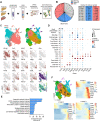This is a preprint.
Hepatic lipid-associated macrophages mediate the beneficial effects of bariatric surgery against MASH
- PMID: 37961666
- PMCID: PMC10635378
- DOI: 10.21203/rs.3.rs-3446960/v1
Hepatic lipid-associated macrophages mediate the beneficial effects of bariatric surgery against MASH
Update in
-
TREM2 macrophages mediate the beneficial effects of bariatric surgery against MASH.Hepatology. 2025 Jun 1;81(6):1776-1791. doi: 10.1097/HEP.0000000000001098. Epub 2024 Sep 18. Hepatology. 2025. PMID: 39292863 Free PMC article.
Abstract
For patients with obesity and metabolic syndrome, bariatric procedures such as vertical sleeve gastrectomy (VSG) have a clear benefit in ameliorating metabolic dysfunction-associated steatohepatitis (MASH). While the effects of bariatric surgeries have been mainly attributed to nutrient restriction and malabsorption, whether immuno-modulatory mechanisms are involved remains unclear. Here we report that VSG ameliorates MASH progression in a weight loss-independent manner. Single-cell RNA sequencing revealed that hepatic lipid-associated macrophages (LAMs) expressing the triggering receptor expressed on myeloid cells 2 (TREM2) increase their lysosomal activity and repress inflammation in response to VSG. Remarkably, TREM2 deficiency in mice ablates the reparative effects of VSG, suggesting that TREM2 is required for MASH resolution. Mechanistically, TREM2 prevents the inflammatory activation of macrophages and is required for their efferocytotic function. Overall, our findings indicate that bariatric surgery improves MASH through a reparative process driven by hepatic LAMs, providing insights into the mechanisms of disease reversal that may result in new therapies and improved surgical interventions.
Conflict of interest statement
Additional Declarations: There is NO Competing Interest.
Figures






References
-
- Younossi Z. et al. Global burden of NAFLD and NASH: trends, predictions, risk factors and prevention. Nature reviews. Gastroenterology & hepatology 15,11–20 (2018). - PubMed
-
- Marengo A., Jouness R.I. & Bugianesi E. Progression and Natural History of Nonalcoholic Fatty Liver Disease in Adults. Clinics in liver disease 20,313–324 (2016). - PubMed
-
- Tilg H. & Moschen A.R. Evolution of inflammation in nonalcoholic fatty liver disease: the multiple parallel hits hypothesis. Hepatology (Baltimore, Md.) 52,1836–1846 (2010). - PubMed
-
- Schuster S., Cabrera D., Arrese M. & Feldstein A.E. Triggering and resolution of inflammation in NASH. Nat Rev Gastroenterol Hepatol 15,349–364 (2018). - PubMed
-
- Yanovski S.Z. & Yanovski J.A. Obesity. The New England journal of medicine 346,591–602 (2002). - PubMed
Publication types
Grants and funding
LinkOut - more resources
Full Text Sources

